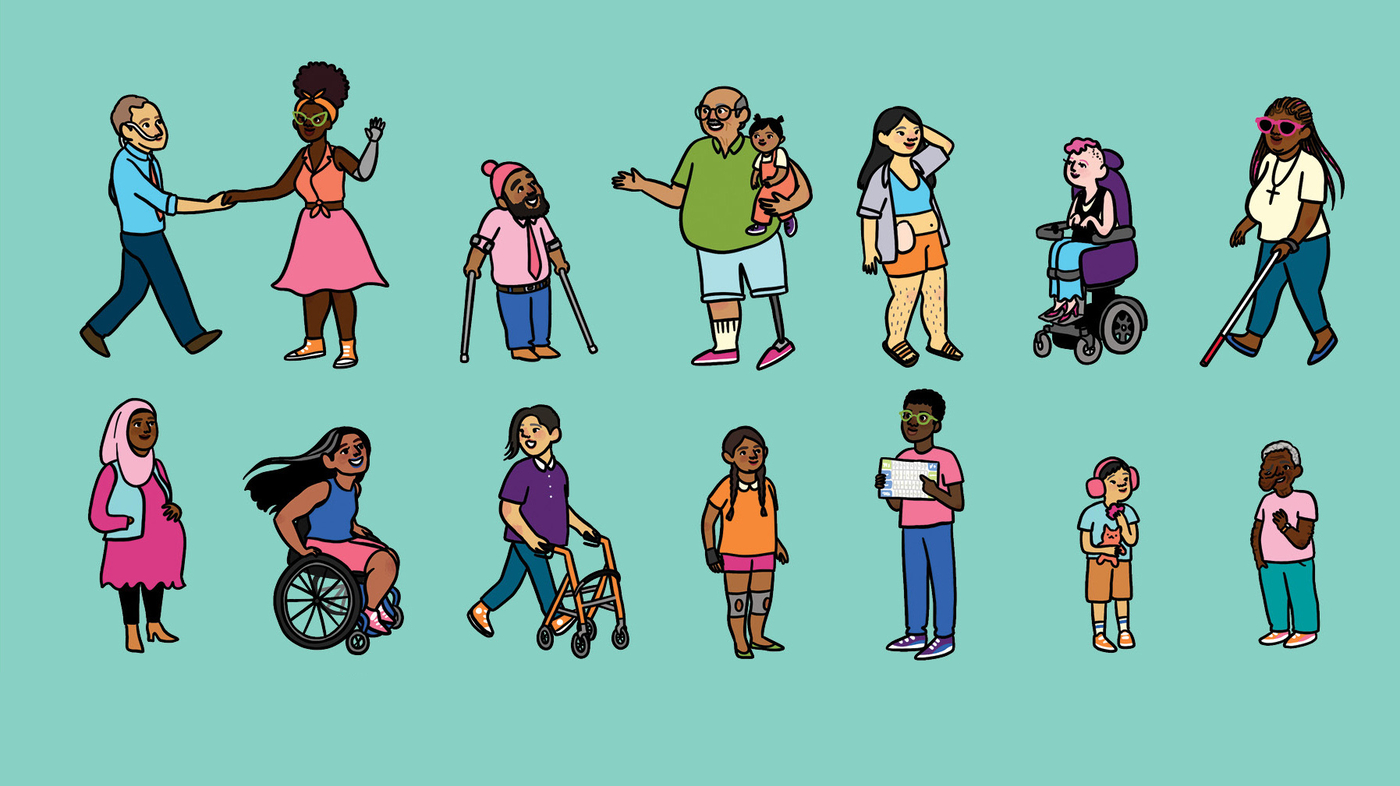
Tyler Feder/Ten Speed Press
Tyler Feder/Ten Speed Press
Let’s start with the numbers.
More than one billion people, or about 15% of the world’s population, have some kind of disability. In the United States alone, about 61 million people, or one in four adults, live with at least one disability.
So it’s safe to say that you know someone with a disability, or you may have a disability yourself. To be clear, these disabilities are not physical or visible. They can be a range of disabilities, including learning disabilities, developmental disabilities, intellectual disabilities, mental illnesses, chronic illnesses, and more.
Yet despite the commonality of disability, not many people know how to talk about it or interact with people who have a disability.
“To many people, [disability] “This incredibly frightening and overwhelming subject remains a mystery,” says disability rights activist and author Emily Radau. “We don’t talk about it. We ignore it. We push it away. We hide it. But that shouldn’t be the case with disability, because it’s simply part of what makes people who they are.”
In her book, Demystifying Disability: What to Know, What to Say, and How to Be an Ally, Radau shares her thoughts on how people with and without disabilities can work together to make the world a more inclusive and accessible place.

Emily Radau is a disability advocate, speaker, and author of Demystifying Disability: What to Know, What to Say, and How to Be an Ally. Left: Ten Speed Press, Right: Rick Guidotti Hide caption
Toggle Caption Left: Ten Speed Press, Right: Rick Guidotti
Radau, a wheelchair user with multiple disabilities, points out that there is no single story about the disability experience, and while it is not the responsibility of people with disabilities to educate non-disabled people about the nuances of disabled life, she says progress comes through dialogue.
“I believe providing honest, sincere guidance and dialogue is a key part of progress for people with disabilities. That’s how disability activists before me have made progress, and that’s how we will continue to make progress,” she wrote.
We spoke with Radau about what advice he would give to anyone (disabled or not) who wants to be a better ally for people with disabilities in America and help eliminate stigma against them.
What is a disability?
Disability is a natural part of the human experience, Radau says. What it means to be disabled is not a single experience, and being disabled or having a disability is certainly not inherently bad or shameful. So we shouldn’t use the words disabled or disability. They’re not bad words.
What is disability discrimination?
Radau defines ableism as “attitudes and behaviors that devalue others because of their disability.” Ability discrimination exists in many different forms and places. It can be something as small as someone asking about your disability, or as big as limited access to public transportation, which provides people with disabilities with access to employment, education, and even health care.
One size does not fit all.

Cover image of “Demystifying Disability: What to Know, What to Say, and How to Be an Ally” by Emily Radau. Tyler Feder/Ten Speed Press Hide caption
Toggle caption Tyler Feder/Ten Speed Press
Part of the cover of “Demystifying Disability: What to Know, What to Say, and How to Be an Ally” by Emily Radau.
Tyler Feder/Ten Speed Press
There is no one disability community. “If you’ve met a disabled person, you’ve met a disabled person,” Radau says. Each person with a disability has their own unique experience with their disability. For example, in Radau’s family, she, her mother, and her uncle have the same rare genetic disorder. But the disability manifests and affects each person differently. One person’s experience can influence another’s, but one experience does not reflect the experience of the entire community.
Learn and use the right language.
“Language is one of the most important signals we use to accept or reject someone’s identity,” says Radau. In her book, she lists words that shouldn’t be used and suggests words to use instead. Here are some of her suggestions:

Emily Radau/Ten Speed Press
It takes constant effort to be an ally.
“Being an ally isn’t just about holding the door for someone or using the right terminology and then being done with it and saying, ‘I was a good ally today,'” Radau says.
It goes back to the idea of recognizing what a stereotypically disabled person looks like and understanding how a black and disabled person, or a transgender and disabled person, experiences disability differently than a white woman in a wheelchair.
“To me, being an ally means asking, ‘Who has a seat at the table?'” Radau said. “It’s a constant learning process, and it can be difficult, but the more we know, the better we can do.”
Additional resources
Books
movie
Crip Camp: A Disability Revolution (2020) Sins Invalid: An Honest Claim to Beauty (2013)
video
The podcast portion of this story was produced by Sylvie D’Aglis.
We want to hear from you, so if you have a great life hack, leave us a voicemail at 202-216-9823 or email us at [email protected] and your tip could be featured on an upcoming episode.
If you love Life Kit and want more information, subscribe to our newsletter.



